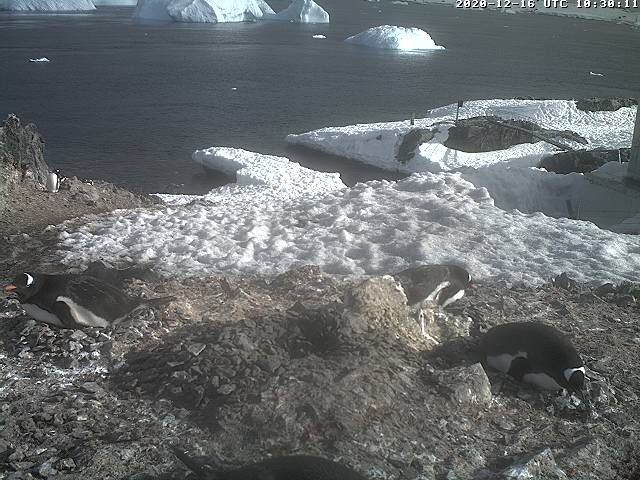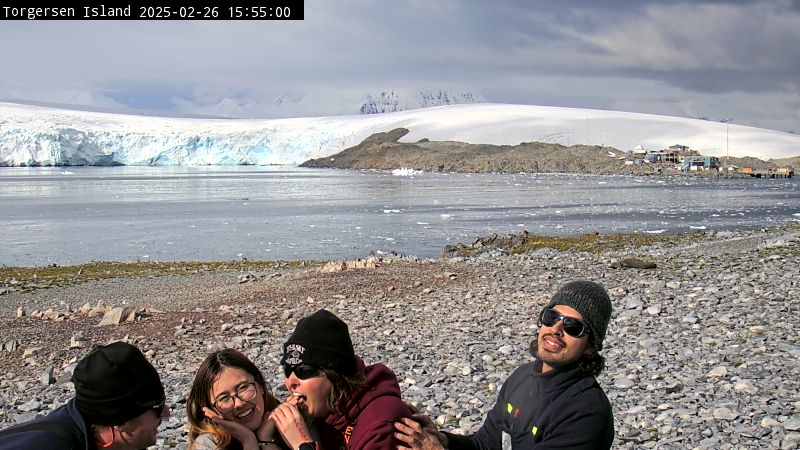From the South Georgia December 2009 Newsletter:
Famine And Feast
Early signs of a lack of krill in South Georgia waters were first noticed nearly a year ago when most of the gentoo penguin chicks failed to survive to fledge last summer. In recent weeks though there are plenty of signs that the krill is back.Krill poor years are part of a regular cycle around South Georgia, occurring typically once or twice a decade. During the 1990s there were three krill poor years. In those years the reproductive success of krill dependent predators, such as fur seals and gentoo penguins, was correspondingly low. The 2008/9 krill-poor year may, however, have been more extreme.
Antarctic krill play a pivotal role in the southern ocean ecosystem, especially around South Georgia. They are an important food source for penguins, seals, whales and fish. The exact causes of krill poor years at South Georgia are not known, but are probably caused by changes in ocean currents and the extent of winter sea ice further south.
Normally krill arrives in South Georgia waters swept up in cold water currents from further south around the Antarctic Peninsula where sea ice provides a winter habitat for the krill. The sea surface temperature around South Georgia was more than 1°C warmer in 2009 than in the previous year, indicating the sweep of cold water that brings the krill did not form.
With little or no krill around the predators struggle to feed themselves and their young, leading to high levels of mortality. Scientists, and tour staff on the cruise ships, began noticing lots of dead chicks at the gentoo penguin colonies last summer. A study site at Maiviken had over a thousand nests, but less than half that number hatched successfully and only a handful of chicks survived to fledge. Average hatching success for this species is 90% and of those 85% would usually survive to fledge.
Over the past winter many thin or dead adult gentoo penguins were seen around the coast. How many more died unobserved at sea can only be guessed at, so there has been particular interest to see what would happen when they were due to return to their colonies to breed once again. As the new summer season began GSGSSI produced special posters to try and answer the concerns of tourists visiting the Island. In this they explained that krill-poor years affect survivorship of fur seal pups and the macaroni and gentoo penguin chicks, and they predicted the fur seal and macaroni penguin breeding success would be low for the 2009/10 season ahead, warning people not to be surprised to see “fur seals and penguins in poor condition or even dead animals on the beach during your visit to South Georgia”.
The current breeding season is certainly affected but perhaps it is turning out better than may have been feared. The gentoo penguins were very late returning to the colonies. Whereas last year most of the eggs had been laid by late October, this season it was mid November before the first egg was seen at one site and some birds were still coming up to breed at the end of December. It looks like less than a quarter the number of birds will nest this summer.
It is a similar story with the fur seals. The large numbers of fur seal pups born last year did not fare well as lack of krill for the nursing mothers to feed on meant the pups were underweight and would not have thrived. Many of the poor condition females then failed to breed this following season, they have returned to the beaches but only about half the number of pups have been born compared to last summer.
Macaroni penguins, however, seem to have escaped much of the effect from the lack of krill. numbers fledged at the end of last season, and normal numbers have returned to breed at the beginning of the season this year. Now the good news is that the krill have returned.
By November krill was evident in the pink fur seal scats on the beaches. In November and December krill has also been seen in the bays, proving an attraction to excited gulls, terns and other seabirds to feed on them, also bringing several humpback whales close inland.
Though there are a smaller number of gentoo penguin chicks and fur seal pups this year, they seem to be doing very well. Indeed there are so few carcasses on the beaches that higher predators such as the giant petrels are the ones now struggling to find enough food. And with very low mortality rates compared to normal it is possible that, despite the low numbers hatched and born, the final number surviving this summer to adulthood may not be that different from a more normal year.
By later this summer we will know much of the effect of this latest krill-poor year, but the fate of the gentoo penguins that have not returned to breed this year may only be evident next summer. Maybe year numbers returning to breed will be up again, indicating that this season some adults were just in poor condition and decided not to breed. If however numbers remain low, it may indicate that many died of starvation, in which case the population will then take a lot longer to recover.
The hundreds of thousands of King Penguins that breed on South Georgia appear to be unaffected by the krill-poor season as they mainly feed on lantern fish.
Source



.jpg)





















No comments:
Post a Comment